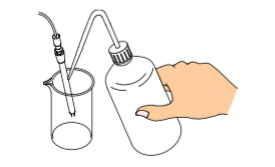ELECTRODE RINSE WITH SHOWER ACCESSORY:
Sample changers that are connected with automatic titrators generally are there for a reason. Efficiency. From an operators point of view getting multiple tests done quickly while being able to take on other tasks in the lab is a key productivity booster. Sample changers offer various sizes ranging from as few as 6 positions for samples up to some of the largest exceeding 50 sample positions. Sample changers either have rotating carousels or an arm that moves electrodes and nozzles from sample to sample. Each time a sample test is completed the electrode must be cleaned before moving on to the next test. Many sample changers offer as standard a dip rinse between sample testing and as the name suggests it's really nothing more then dipping the electrode in clean water or solution. For some samples this process is sufficent but for others it is not enough to effectively clean the electrode before the next test. Luckily most manufacturers of sample changers offer additional cleaning power with the use of a shower rinse system. Below is a video showing how a shower rinse process works. Water is stored in a container and then is flushd and rinsed in one of the sample positions designated as the cleaning station. Water is evacuated via tubes to a drain or sink.



